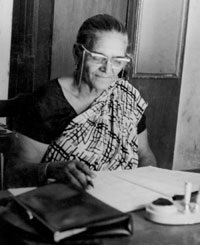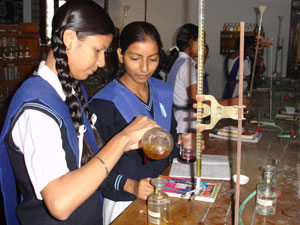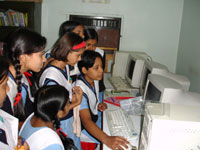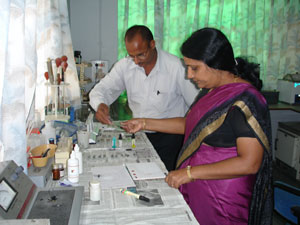All children deserve a quality education. Together, we can help them reach their dreams.
Learn more about Teach for Life, the educational branch of Trees for Life.

Mrs. Sushiela Singh raised her family in the city of Allahabad in northern India. When her children were all grown and her husband of more than 30 years 
died, she turned her attention to a subject close to her heart: providing education to girls from poor families so they could break free from the vicious cycle of poverty.
She started in 1967 by tutoring a couple of neighborhood girls who wouldn?t have had a chance to get educated otherwise. She asked their parents to pay twenty cents a month so that instead of receiving charity, they would be contributing toward their children's education.
Then another girl came. And then another.
The empty rooms formerly occupied by her own children were soon filled with the chatter of dozens of students, who were now "her children." Soon her family home became a small school, with several teachers and additional rooms that had to be built in the backyard.
Lacking funds and resources, she had only her dogged determination to support her. Mrs. Singh sold most of her possessions and literally built the school one brick at a time. She was known to carry home bricks that she found on the street, so that "her children's school" could be built.
When she died in 1989 at the age of 79, she was still putting in twelve hours a day at the school. By that time, there were 400 students from kindergarten through the 8th grade. To honor her beloved husband, she named the school after him: Umrao Singh Memorial School (USMS).
Today it is an "Intermediate College"—the equivalent of a U.S. high school—serving more than 1,000 students through the 12th grade, including boys up to the 5th grade.
1994: Student efforts start high school classes
Until the early nineties, there was no way for students to continue their education beyond the 8th grade. There simply was not enough room or resources at the school.
In 1994 a group of 8th grade girls decided to do something about it. They would assemble necklaces using locally-made wooden fish pendants and sell them to raise funds. The proceeds would build new classrooms and buy the necessary books and supplies for high school classes.
Their initiative caught the attention of schools in the USA, and a partnership began. American students sold the fish necklaces as fundraisers, and the proceeds went toward both their own special projects and helping to establish high school facilities at USMS. Students on both sides of the world joined hands, learning to make things better for themselves and for others.

By the time the girls who started the necklace project were ready to start 9th grade, the High School curriculum required a science lab. Their efforts to build a high school inspired donors to help build and equip physics and chemistry labs to provide a strong education in the sciences.
Also in the early nineties, people at USMS became interested in pre-nursing education. It could be of great value, helping students to be eligible for further schooling and to serve their communities. As a result, in 1994-1995 a volunteer from Scotland helped develop a Home Health Care Course for the science program at USMS. It included study material determined to be most essential for pre-nursing students entering an accredited school.
1995: Computer lab established

In 1995 most students at the school had never seen nor even heard of a computer. At the same time, knowledge of computers was becoming increasingly important in business and industry.
After much discussion, USMS started the first computer lab of any school in the city of Allahabad. It began with 12 donated second-hand computers. The computer lab continues to grow, enabling students to learn skills that will help them prosper in today's world.
"I remember the faces of students peeking through the windows (of the computer lab) with curiosity about what was to come.... Their passion for learning and joy for life was inspiring.... I got the feeling that anything was possible." — Scott Garvey, former volunteer
2001: Medical lab established
Most of the students at USMS come from families that cannot afford even basic health care. Many of their health problems went untreated, making it very difficult to pursue their studies and enjoy their lives.
People at USMS dared to dream of having a medical lab at the school. Such a lab could provide reliable, affordable medical testing for students at USMS as well as people in the surrounding community. It could also provide opportunities for medical education for older students, which could lead to possible careers in medicine.

In 2001, thanks to generous donations from supporters in India and in other countries, the dream of a medical lab became a reality. In its first year, the lab conducted more than 20,000 tests for USMS students, their families, and children in nearby villages. Those that were diagnosed with ailments were also given the proper medication and treatments.
Today, doctors in the community regularly volunteer their time to assist at the school. The children receive general health screenings each year from volunteer physicians, dentists and eye doctors. This initiative has markedly improved the health of the students.
2005: Library inaugurated

Just like in most developing areas of the world, children attending USMS had very little access to reading books. In fact, there was no children's library in the entire city of Allahabad.
In 2005 USMS inaugurated the first children's library of its kind in the city. The library not only provides colorful, illustrated storybooks for the 1,200 students at USMS, but also lends books to other schools in the area.
Innovative English language teaching workshop
USMS is one of the few schools in its neighborhood that teaches English. English proficiency is essential for students, as it opens many real-world opportunities for them.
In 2005, a great contribution toward effective English teaching at the school came when Mr. Blaine Ray, founder of Blaine Ray's TPR Storytelling, held an intensive workshop in language teaching for teachers at USMS and the surrounding community. His TPR (Total Physical Response) Storytelling method for teaching languages is used by thousands of teachers in the USA and internationally.
"I was talking with a cab driver (in New Delhi). He could not say enough about the essential importance of speaking English. As he saw it, his only hope of elevating himself out of the lowest caste standard of living was to learn to speak English." (Learning English) is a real and measurable boost for those who want to move beyond their deep and tragic poverty. The children are enthused to learn English."
— Trees for Life volunteer
Graduates of the school
Over the years, several graduates of USMS have gone on to become lawyers, educators, doctors, administrators and business people. They are shining examples of how education can help break the grip of poverty so that individuals can achieve their potential and contribute to their society.
Testimonials from visitors to USMS:
"We went to India not knowing what to expect. We witnessed the blossoming of young minds and smiles on tender faces as they realized their potential."
— Kathy Miller, Volunteer
"Bluntly speaking, I had gone to India to see how my money was being used.... I had gone to see poverty and suffering. I had gone to see people I could help. Instead I found life, laughter, and sharing.... And in the eyes of a little school girl I found overwhelming love and respect. It was a look unspoiled by worldly possessions. In her eyes I was not a stranger.... What I found awakened the spirituality within me."
— Trees for Life volunteer and supporter